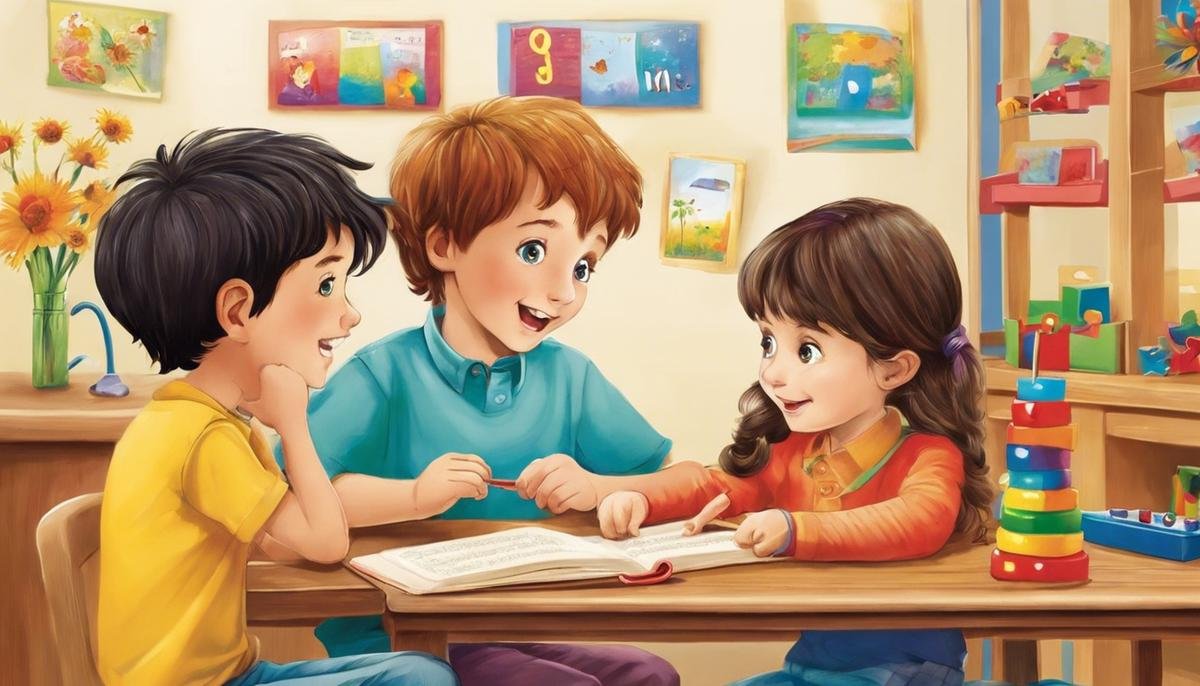
In the intricate maze of human communication, individuals with autism often find unique paths to express themselves, with speech repetition being a common manifestation. Autism, a complex developmental disorder, impacts social interaction, communication skills, and a wide range of behaviors. Among the myriad facets, speech repetition is often seen in autistic children. However, it’s frequently misunderstood or seen merely as a result of communication barriers. This paper aims to elucidate the understanding of autism and the phenomenon of speech repetition, carefully expounding the science behind it, and the numerous ways it unfolds in children with autism. We’ll also delve into the diverse kinds of speech repetition, such as echolalia, scripted language, and palilalia, backing it up with research and professional insight.
Understanding Autism and Speech Repetition
Understanding Speech Repetition in Autism: A Common Characteristic Explored
Hello, Loving Parents and Dedicated Caregivers! Autumn leaves bring a chill in the air, reminding us all to bundle up our little ones and cherish shared moments by the fireside. Today, let’s venture into the intriguing world of autism, and a common characteristic that many children with this condition exhibit – speech repetition.
What is Speech Repetition?
Often noticed as an echo of phrases previously heard, speech repetition in children with autism, technically known as echolalia, is more than mere mimicry. It is a beautiful, yet complex puzzle, which catches the essence of autistic communication. Imagine a lovely seven-year-old who repeats, “Want more coffee?” without any interest in the beverage. This isn’t about their caffeine curiosity, it’s them using a phrase they’ve picked up to communicate their desire for something else.
Characteristics of Speech Repetition
Now that we understand what speech repetition is, let’s delve into its heart by exploring its characteristics.
- Delayed Echolalia: This involves the reproduction of a phrase or sound that was previously heard, but not immediately. The child could repeat something heard days, weeks, or even months ago!
- Instant Echolalia: Here, the child repeats what is heard immediately, like an echo where the sounds ring out as soon as they hit the walls of a canyon.
- Interaction or Non-interaction: Sometimes, the repeated phrases intend interaction or response, but at other times, they may serve just personal satisfaction.
- Metaphorical Language: Often these repeated words or phrases are metaphorically used to express feelings, emotions, or needs.
Why is Speech Repetition Common in Autism?
The question that looms large in the minds of parents is, “Why?” Why does a child with autism commonly resort to speech repetition? This attribute is seen as functional. It’s a bridge that connects their internal world with the external one.
Children with autism often face challenges in understanding and using language the way we do. For them, typical language might be brimming with abstract concepts and complex grammar, causing feelings of overwhelming confusion. Thus, repeating phrases and sentences they’ve heard before, they try to communicate within their comfort zone.
Moreover, repetition can serve as a self-stimulatory activity or ‘stimming,’ providing self-comfort in an overwhelming environment or even expressing delight.
Understanding can Mean Support
Our children’s uncommon behaviors can sometimes leave us puzzled or concerned. Yet, once we unwrap our perspective and truly see, we could marvel at the creativity behind and empathize with their struggles. As parents, our role is vital in supporting and building a nurturing environment that fuels the growth of our precious ones.
Remember, every child is unique irrespective of autism or not, and their words, repetitive, or not are crucial steps towards the fantastic journey of their expressive self. So, let’s aim to understand, appreciate, and encourage their distinctive speech patterns while lending a patient ear to their unique interpretations of the world!
It’s evident; understanding speech repetition in autism invites an opportunity to enhance communication, fostering an enriching relationship between you and your child. After all, love is about understanding, isn’t it?
Until next time, keep nurturing with love and warmth,
[ your name ]

Photo by itfeelslikefilm on Unsplash
The Types of Speech Repetition in Autism
Embarking on a deeper understanding of speech repetition in children with autism, it becomes clear that it can present in a multitude of forms. Keeping in mind our initial discussion about echolalia, let’s expound on some other types of speech repetition we often see in autistic children.
One such type is Mitigated Echolalia, where children repeat sentences but make slight modifications to them. This could involve changing one or more words, hence altering the meaning or context of the sentence. An example can be if a child is asked, “Do you want apple juice?” they may respond, “You want apple juice.” This nuanced form of speech repetition sheds light on how children with autism navigate language, illustrating their attempts at dialogue.
Then there are scripts, also known as movie dialogue or scripting. This involves a child repeating lines from movies, shows, or even commercials. At times, it could seem irrelevant to the situation, but for them, it serves as a functional part of their communication, much like a language of their own. Scripts can serve various purposes – they can express feelings, provide comfort, or even facilitate social interaction.
Closely related to scripts is Verbatim Language Learning. Children with autism often learn new words or sentences exactly as they hear them, including the tone and inflection. This results in them repeating phrases with literal precision, echoing the rhythm, intonation, and emotion conveyed by the speaker.
Somewhat analogous to this is Perseveration, which involves repetition of a word or phrase after a pause. This often surfaces in moments of stress or excitement. It’s as if the child gets fixated on a particular phrase and uses it as a self-soothing mechanism to navigate situations that feel overwhelming.
Finally, there are Palilalia and Logorrhea. Palilalia refers to repeating one’s own words or sounds, akin to echoing oneself. Meanwhile, Logorrhea features excessive wordiness and chatter, often leading to drawn-out, repetitive dialogues.
It’s exemplary how these varied forms of speech repetition furnish us with a glimpse into the distinct ways children with autism engage with language. These are not anomalies, rather manifestations of their unique language ecosystem. Instead of trying to fix them, we should celebrate this diversity, recognizing it as a part of their unique identity.
Approaching autistic children’s language with understanding and empathy can create a more inclusive and supportive environment for them. Remember, every child has a unique voice and perspective that deserves to be heard and respected. Whether they repeat words, echo sentences, or narrate scripts, they are communicating in their own unique way. Let us cherish these unique expressions and continue to support our wonderful children in their remarkable journey.

Strategies for Managing Speech Repetition
These beloved kiddos with autism can display an array of communication styles. One of them you may have heard about is Mitigated Echolalia. Now, you may be thinking – what in the world does that mean? It’s simply when your kiddo modifies the phrases or sentences they repeat. So, if someone asks, “Do you want a cookie?” your child might reply, “Do you want a cookie?” rather than a simple “yes.” While it may seem confusing, it’s their special way of communicating their needs.
Similarly, some children may embrace the magical world of movies or their favorite TV shows and use scripts or dialogue in everyday conversation. Imagine having a conversation punctuated by profound wisdom from Yoda or the sprightly enthusiasm of SpongeBob SquarePants! The rainbow of personalities in their language can certainly add vibrant colors to our day while also providing comfort, familiarity, and a fun way for them to express their thoughts.
An autistic child might also adopt verbatim language learning. This method involves learning and understanding language exactly as it is presented. It presents a unique take on language absorption, blending memory skills with conversational abilities.
There’s also a fascinating behavior called perseverance, where children might stick to one topic and circle back to it in conversation. Sometimes, they’ll repeat a word or phrase directly after speaking it, a quirk known as palilalia. In more extreme cases, intense streams of speech, termed ‘logorrhea,’ may be observed.
Recognizing these diverse communication styles helps us celebrate the linguistic diversity in our little ones. By embracing their unique voices, we break the barriers and create an inclusive space where every child feels seen and heard. Sensitivity to their communication styles combined with patient, loving interactions forms a safe cocoon for them to unfurl their linguistic wings.
As parents or caregivers, understanding is our most potent tool in building a supportive environment. We become bridges, helping them connect with a world that may sometimes seem overwhelming. We are their champions, celebrating every whispered word or animated monologue. A simple adjustment, such as waiting and giving them time to articulate their thoughts, can make all the difference. Echoing their words in response to confirm understanding can also encourage more purposeful and positive communication.
Autistic children have a unique perspective on the world that we, as parents, are privileged to experience. By honoring their distinctive communication styles in everyday interaction, we open up a universe of shared understanding and connection. Our children’s voices, no matter how they express them, deserve to be heard, cherished, and respected. After all, each family’s symphony is composed of these unique voices!
While managing speech repetition may come with its set of challenges, navigating this journey together, driven by unwavering love and understanding, can help us inch closer towards making our homes a haven for our special ones, where their language isn’t just heard but also understood and appreciated for its unique beauty.

Speech Repetition: A Sign of Comfort, Not Just a Complication
Understanding the Role of Speech Repetition in Autistic Children
Have you ever noticed a child with autism continually revisiting a subject they find captivating, guiding the conversation back to it like a well-loved book? That’s a form of speech repetition known as perseveration. For many autistic children, this may not be an indication of difficulty but rather an expression of intense interest and enjoyment.
Another verbal behavior characteristic of some children with autism is palilalia – the immediate and often rapid repetition of words or phrases. It might seem disruptive at first glance, but it’s critical to remember that this could either be a form of self-stimulation or a way to manage anxiety or excitement.
Logorrhea, an outpouring of a rapid, intense stream of speech, can also be seen in some autistic children. Though it may sound like a flood of words to an outsider, each word might carry special meaning for the child, providing them with a unique form of self-expression.
In addition, some children with autism exhibit mitigated echolalia, wherein the repeated words or phrases may be changed slightly to suit the current context. This demonstrates a child’s attempt at using language functionally but in a way that may seem unusual to those unfamiliar with the behavior.
You may have also observed children with autism using scripts or repeating chunks of dialogue from their favorite TV shows or movies. This behavior, known as scripting, is often part of a broader category of speech repetition referred to as verbatim language learning. For these children, these scripts can be a helpful tool for navigating social situations or expressing their thoughts and feelings.
Acknowledge Every Unique Voice
In the mist of these varied forms of speech repetition, it’s important to celebrate the linguistic diversity among children with autism. Every child has a unique way of seeing the world, and their communicative style is a reflection of their unique perspective. It’s not about right or wrong; it’s about understanding and appreciating the way each child communicates.
Create a Supportive Environment
As parents or caregivers, the best thing we can do is create an understanding and supportive environment for children with autism. This means adjusting our communication styles to accommodate their needs, encouraging purposeful and positive communication, and providing them with the guidance they need to express themselves.
Respect Their Unique Communication Styles
Remember, as much as we mold our children, they equally shape us. It’s not about forcing them into a box but adapting and learning to understand their unique communication styles. We have to adjust ourselves and develop empathy towards their unique neural wiring.
Speech repetition in autism offers an opportunity for us to truly appreciate the richness of individual communication styles. By understanding and empathizing with these forms of self-expression, we can better navigate any challenges, creating a positive and inclusive environment for all our children, valuing their diverse voices, and celebrating their extraordinary perspectives. Let’s guide with love and understanding, cherishing every single word they share.
Photo by daen_2chinda on Unsplash
Speech repetition in autism isn’t just a hurdle to communication, it can also serve as a source of comfort for autistic children. The mere act of reducing it to a complication does not do justice to understanding the complexity of autism. Instead, acknowledging it as a comforting mechanism can contribute meaningfully to fostering a supportive and respectful environment for those experiencing autism. Through research-backed strategies, therapies, and interventions, parents and caregivers can navigate the complex landscape of speech repetition in autism, paving the way for progress and development. With patience and understanding, we firmly believe that every child, regardless of how they are wired, can express themselves more functionally, naturally, and beautifully.




